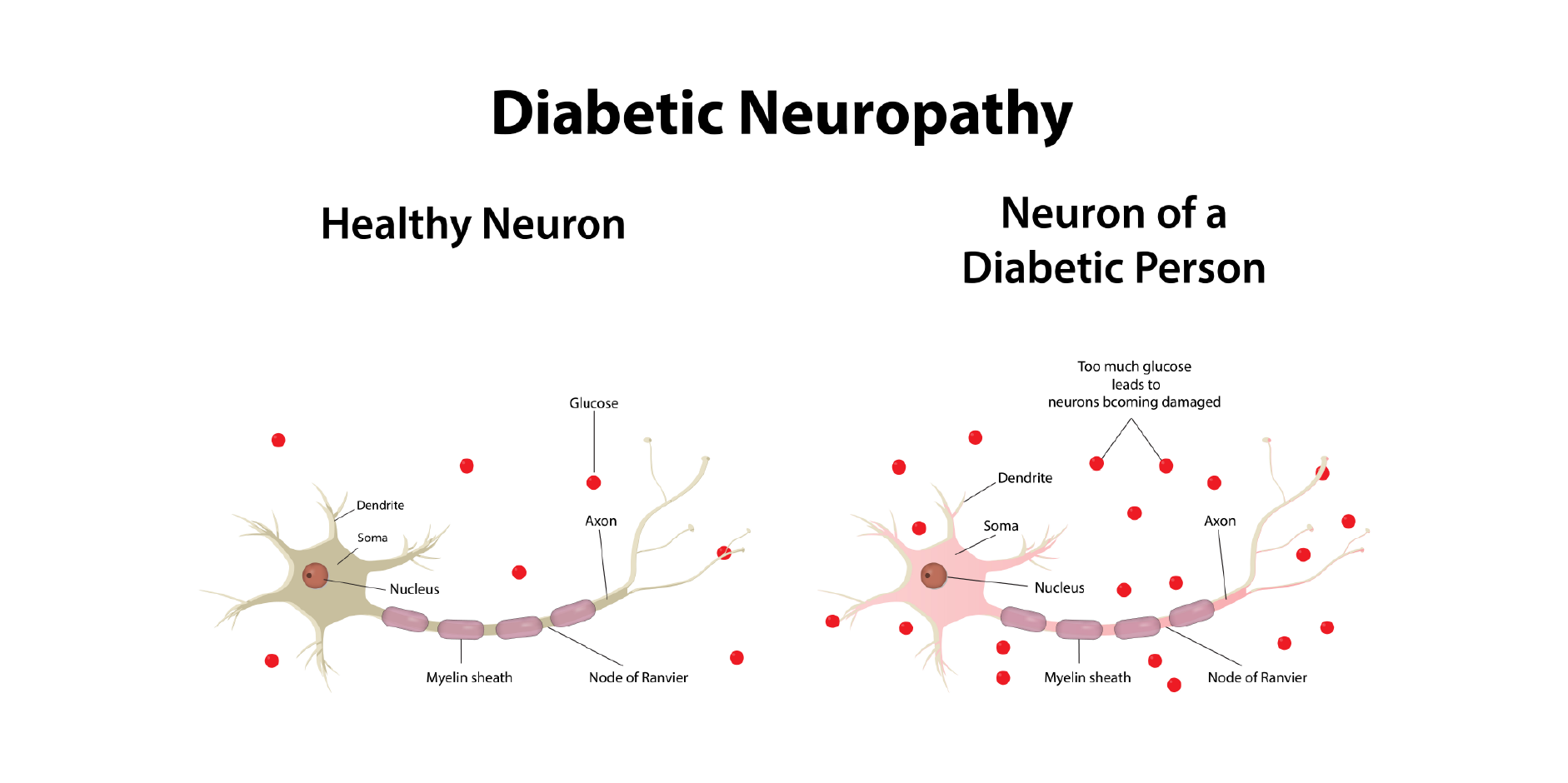Content on this page:
Content on this page:
Introduction
Diabetic neuropathy is a group of progressive, degenerative conditions involving autonomic, motor, or sensory peripheral nerves that develop in patients with diabetes mellitus (DM) and cannot be attributed to other causes of peripheral neuropathy, thus making it a diagnosis of exclusion.
Epidemiology
Diabetic neuropathy is the most common chronic complication of
diabetes, affecting about 50% of DM patients. It is noted to be more common in
adults >50 years of age and in patients with type 2 DM. It is also the most
common form of neuropathy observed in developed countries. Notably, the
prevalence of diabetic neuropathy is a function of disease severity and
duration; the prevalence increases with disease duration. Among the different
forms of diabetic neuropathies, diabetic peripheral neuropathy (DPN) is the
most common and the most studied. While the noted prevalence for DPN in type 1
DM patients is roughly 11 to 13%, more than half of all individuals with type 2
DM develop DPN.
Studies in Malaysia show diabetic neuropathy has an estimated
prevalence of around 10 to 30%. In the Philippines, DM is also the leading
cause of neuropathy, 42% of DM patients suffering from it.
Pathophysiology
The pathogenesis of diabetic neuropathy is multifactorial and is mainly
due to oxidative and inflammatory stress in association with metabolic
dysfunction, which ultimately causes nerve cell damage.
 Diabetic Neuropathy_Disease Background
Diabetic Neuropathy_Disease BackgroundRisk Factors
Risk factors for diabetic neuropathy include both unmodifiable and
modifiable components. Unmodifiable risk factors include advanced age and the
duration of diabetes, with the risk of developing neuropathy increasing as both
age and disease duration progress. Height is also an independent predictor of
neuropathy in both type 1 and type 2 DM patients.
Modifiable risk factors include hyperglycemia, abdominal obesity,
dyslipidemia (particularly hypertriglyceridemia, which increases the risk of
distal symmetric polyneuropathy by 2.1 times), elevated low-density lipoprotein
cholesterol (LDL-C), and reduced high-density lipoprotein cholesterol (HDL-C).
Additional modifiable risk factors include hypertension, obesity (body mass
index [BMI], weight, and waist circumference are associated with neuropathy),
smoking, and heavy alcohol consumption.
Classification
Classification of Diabetic Neuropathies
Diffuse or Generalized Neuropathies
Diabetic sensorimotor polyneuropathy is a symmetrical, length-dependent
sensorimotor polyneuropathy that is due to metabolic and microvessel
alterations resulting from chronic hyperglycemia exposure and cardiovascular
risk covariates. It is the most common form of diabetic neuropathy, affecting
about 75% of DM patients. Diabetic sensorimotor polyneuropathy affects up to
50% of type 2 DM patients with >10 years of diabetes, and at least 20% of
type 1 DM patients with long-standing diabetes (≥20 years). It may be present
in at least 10–15% of newly diagnosed type 2 DM patients. Diabetic sensorimotor
polyneuropathy follows a chronic and progressive course and is the most common
cause of foot ulceration and lower extremity amputation. It must be noted that
Charcot neuroarthropathy may also predispose patients to ulceration and
amputation. Diabetic sensorimotor polyneuropathy typically has an insidious
onset, beginning from distal and progressing proximally to the extremities
affecting the toes and soles of the feet first then gradually ascending the
legs. Symptoms at the fingertips and hands manifest usually when the distal
extremity symptoms have reached the knees. Painful diabetic sensorimotor
polyneuropathy is more common in patients with a longer duration of diabetes
and poor glycemic control.
Diabetic autonomic neuropathies usually occur in patients with
long-term diabetes (≥20 years). They affect the sympathetic, parasympathetic,
and enteric nerves. One form is cardiovascular autonomic neuropathy (CAN),
which involves impairment of the autonomic control of the cardiovascular
system. The prevalence of CAN increases with the duration of diabetes. It may
cause prolonged QT interval in type 1 DM patients, leading to life-threatening
cardiac arrhythmias and sudden cardiac death. Additionally, CAN may delay the
diagnosis of silent or asymptomatic myocardial infarction due to reduced
recognition of ischemic pain. Gastrointestinal (GI) autonomic neuropathy, which
may involve any portion of the GI tract, tends to occur later in the course of
diabetes. Urogenital autonomic neuropathy can manifest as diabetic cystopathy
or neurogenic bladder, erectile dysfunction, or female sexual dysfunction.
Sudomotor dysfunction manifests as distal hypohidrosis or anhidrosis, or as
gustatory sweating. Another rare form of diabetic neuropathy is acute sensory
diabetic neuropathy which may be subdivided into treatment-induced neuropathy
and neuropathic cachexia. Treatment-induced neuropathy, or insulin neuritis, is
an iatrogenic form of neuropathy caused by rapid glycemic control in the
setting of chronic hyperglycemia. Diabetic neuropathic cachexia is a rare form
of symmetrical painful neuropathy that usually affects the lower extremities
and lower trunk.
Mononeuropathy or Focal Neuropathies
Mononeuropathy or focal neuropathies include isolated cranial
neuropathies (eg cranial nerves [CN] III, IV, VI, VII) which usually occur in
older DM patients with long-term diabetes. These also encompass isolated
peripheral nerve neuropathies (eg ulnar, median, femoral, peroneal nerves).
Entrapment neuropathies are estimated to occur in approximately one-third of DM
patients. Most common of which is carpal tunnel syndrome, which is seen in 30%
of patients with diabetic polyneuropathy and ulnar neuropathy, which is seen in
2.1% of patients with diabetes. Additionally, mononeuritis or mononeuropathy
multiplex may occur, wherein multiple nerves are involved.
Radiculopathy or Polyradiculopathy or Multifocal Neuropathies
Radiculopathy, polyradiculopathy, or multifocal neuropathies include
diabetic radiculoplexus neuropathy, which may present as cervical
radiculoplexus neuropathy, thoracic radiculoneuropathy, or lumbosacral
polyradiculopathy. Both cervical and thoracic forms affect motor, sensory, and
autonomic nerve fibers. Thoracic radiculoneuropathy primarily affects type 2 DM
patients. Lumbosacral polyradiculopathy, or proximal motor amyotrophy, is the
most frequent type of diabetic radiculoplexus neuropathy and affects about 1%
of middle-aged patients with type 2 DM who have mild glucose metabolism
impairment.
